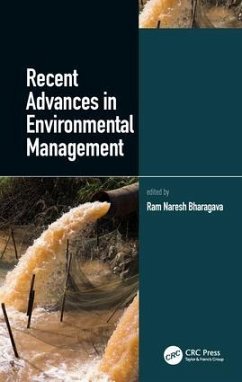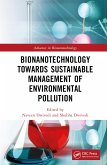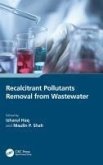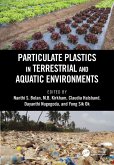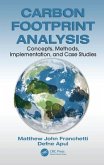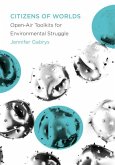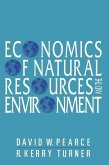Recent Advances in Environmental Management
Herausgeber: Bharagava, Ram Naresh
Recent Advances in Environmental Management
Herausgeber: Bharagava, Ram Naresh
- Gebundenes Buch
- Merkliste
- Auf die Merkliste
- Bewerten Bewerten
- Teilen
- Produkt teilen
- Produkterinnerung
- Produkterinnerung
This book focuses on toxicity of various organic and inorganic pollutants, their eco-toxicological effects and eco-friendly approaches for remediation of environmental pollutants. Researchers working in field of bioremediation, phytoremediation, waste management will find this compilation useful.
Andere Kunden interessierten sich auch für
![Bionanotechnology Towards Sustainable Management of Environmental Pollution Bionanotechnology Towards Sustainable Management of Environmental Pollution]() Bionanotechnology Towards Sustainable Management of Environmental Pollution165,99 €
Bionanotechnology Towards Sustainable Management of Environmental Pollution165,99 €![Recalcitrant Pollutants Removal from Wastewater Recalcitrant Pollutants Removal from Wastewater]() Recalcitrant Pollutants Removal from Wastewater95,99 €
Recalcitrant Pollutants Removal from Wastewater95,99 €![Bassett's Environmental Health Procedures Bassett's Environmental Health Procedures]() W.H. Bassett (formerly Chief Executive and Director of Housing andBassett's Environmental Health Procedures218,99 €
W.H. Bassett (formerly Chief Executive and Director of Housing andBassett's Environmental Health Procedures218,99 €![Particulate Plastics in Terrestrial and Aquatic Environments Particulate Plastics in Terrestrial and Aquatic Environments]() Particulate Plastics in Terrestrial and Aquatic Environments75,99 €
Particulate Plastics in Terrestrial and Aquatic Environments75,99 €![Carbon Footprint Analysis Carbon Footprint Analysis]() Matthew John FranchettiCarbon Footprint Analysis154,99 €
Matthew John FranchettiCarbon Footprint Analysis154,99 €![Citizens of Worlds: Open-Air Toolkits for Environmental Struggle Citizens of Worlds: Open-Air Toolkits for Environmental Struggle]() Jennifer GabrysCitizens of Worlds: Open-Air Toolkits for Environmental Struggle26,99 €
Jennifer GabrysCitizens of Worlds: Open-Air Toolkits for Environmental Struggle26,99 €![Economics of Natural Resources and the Environment Economics of Natural Resources and the Environment]() David W. PearceEconomics of Natural Resources and the Environment41,99 €
David W. PearceEconomics of Natural Resources and the Environment41,99 €-
-
-
This book focuses on toxicity of various organic and inorganic pollutants, their eco-toxicological effects and eco-friendly approaches for remediation of environmental pollutants. Researchers working in field of bioremediation, phytoremediation, waste management will find this compilation useful.
Hinweis: Dieser Artikel kann nur an eine deutsche Lieferadresse ausgeliefert werden.
Hinweis: Dieser Artikel kann nur an eine deutsche Lieferadresse ausgeliefert werden.
Produktdetails
- Produktdetails
- Verlag: Taylor & Francis Inc
- Seitenzahl: 530
- Erscheinungstermin: 8. Oktober 2018
- Englisch
- Abmessung: 239mm x 163mm x 33mm
- Gewicht: 924g
- ISBN-13: 9780815383147
- ISBN-10: 0815383142
- Artikelnr.: 53210541
- Herstellerkennzeichnung
- Libri GmbH
- Europaallee 1
- 36244 Bad Hersfeld
- gpsr@libri.de
- Verlag: Taylor & Francis Inc
- Seitenzahl: 530
- Erscheinungstermin: 8. Oktober 2018
- Englisch
- Abmessung: 239mm x 163mm x 33mm
- Gewicht: 924g
- ISBN-13: 9780815383147
- ISBN-10: 0815383142
- Artikelnr.: 53210541
- Herstellerkennzeichnung
- Libri GmbH
- Europaallee 1
- 36244 Bad Hersfeld
- gpsr@libri.de
Dr. Ram Naresh Bharagava was born in 1977 and completed school education from Government Schools at Lakhimpur Kheri, Uttar Pradesh (U.P.), India. He received B.Sc. (1998) in Zoology, Botany and Chemistry from University of Lucknow, Lucknow, U.P., India and M.Sc. (2004) in Molecular Biology and Biotechnology from Govind Ballabh Pant University of Agriculture & Technology (GBPUAT), Pantnagar, Uttarakhand, India. He received Ph.D (2010) in Microbiology jointly from Environmental Microbiology Division, CSIR-Indian Institute of Toxicology Research (CSIR-IITR), Lucknow and Pt. Ravishankar Shukla University, Raipur, Chhattisgarh, India. He qualified twice (2002 & 2003) CSIR-Junior Research Fellowship (JRF) and Graduate Aptitude Test in Engineering (GATE) in 2003. He was Junior and Senior Research Fellow (JRF/SRF) during his Ph.D. His major research work during Ph.D was focused on the bacterial degradation and detoxification of recalcitrant melanoidin from distillery wastewater. He has been authored one book entitled "Bacterial Metabolism of Melanoidins" and edited three books entitled "Bioremediation of Industrial Pollutants", "Environmental Pollutants and their Bioremediation Approaches" and "Emerging and Ecofriendly Approaches for Waste Management". He has authored and coauthored a number of research/review papers and two-book review in national and international journal of high impact factor published by Springer, Elsevier and Taylor & Francis Group etc. He has also written many chapters for national and international edited books. He has published many scientific articles and popular science articles in news papers and national and international magazines, respectively. He has been presented many papers relevant to his research areas in national and international conferences. He is also serving as a potential reviewer for various national and international journals in his respective areas of the research. He has been also awarded a postdoctoral appointment at CSIR-IITR, Lucknow, but left the position after a while and subsequently joined (2011) Babasaheb Bhimrao Ambedkar (Central) University, Lucknow, UP, India, where he is working as Assistant Professor of Microbiology and actively engaged in teaching at postgraduate and doctoral level and research on the various Government of India (GOI) sponsored projects in the area of Environmental Toxicology and Bioremediation at Laboratory for Bioremediation and Metagenomics Research (LBMR) under Department of Environmental Microbiology (DEM). University Grants Commission (UGC) and Department of Science and Technology (DST), India have supported his research. He has been the advisor to fourty postgraduate students and currently, the mentor of one project fellow and six doctoral students. His major thrust areas of research are the Toxicology, Biodegradation and Bioremediation of Environmental Pollutants, Metagenomics and Wastewater Microbiology. He is a member of the Academy of Environmental Biology (AEB), Association of Microbiologists of India (AMI), and Biotech Research Society (BRSI), Indian Science Congress Association (ISCA), India. In spare time, he enjoys roaming in peaceful environments and spends maximum time with his family. He lives in south Lucknow with his wife (Ranjana) and three kids (Shweta, Abhay and Shivani). He can be reached at bharagavarnbbau11@gmail.com, ramnaresh_dem@bbau.ac.in.
Industrial wastewaters: the major sources of dyes contamination in
environment, ecotoxicological effects and bioremediation approaches
Groundwater pollution by emerging industrial pollutants and its remediation
techniques Textile industry wastewater: Environmental and health hazards
and treatment approaches Environmental pollution from acid mine drainage
and its management approaches Nanotechnology: An emerging technology for
bioremediation of environmental pollutants Application of nano-materials in
sub-surface remediation techniques: challenges and future prospects
Microalgae: An eco-friendly tools for the treatment of industrial
wastewaters and biofuel production Phycoremediation of distillery
wastewater: nutrients uptake by microalgae Fungal cell immobilization for
treatment of industrial wastewaters: Application and perspectives
Mycoremediation: the role of fungi in bioremediation of environmental
pollutants Consequences of heavy metals pollution in environment and
bioremediation practices Chromium contamination in environment, health
hazards and bioremediation approaches Plant-microbe symbiosis: a
synergistic approach for heavy metals bioremediation Constructed Wetlands:
An emerging phytotechnology for the treatment of industrial wastewaters
Petroleum hydrocarbons: Environmental contamination, toxicity and
bioremediation approaches Bioremediation of chlorinated and aromatic
petrochemical pollutants in multi-phase media and oily sludge Microbes: an
ecofriendly tools for bioremediation of pesticides contaminated environment
Biodegradation of polycyclic aromatic hydrocarbons using fungi: A new
prospect toward CYP enginery Environmental pollution and threats from
improper solid waste management Biomedical wastes: Environmental risks,
health hazards and management approaches Applications of metagenomics
approaches in bioremediation of environmental pollutants Application of
hairy root culture technology in phytoremediation for environment clean up:
Past, Present and Future Outlook
environment, ecotoxicological effects and bioremediation approaches
Groundwater pollution by emerging industrial pollutants and its remediation
techniques Textile industry wastewater: Environmental and health hazards
and treatment approaches Environmental pollution from acid mine drainage
and its management approaches Nanotechnology: An emerging technology for
bioremediation of environmental pollutants Application of nano-materials in
sub-surface remediation techniques: challenges and future prospects
Microalgae: An eco-friendly tools for the treatment of industrial
wastewaters and biofuel production Phycoremediation of distillery
wastewater: nutrients uptake by microalgae Fungal cell immobilization for
treatment of industrial wastewaters: Application and perspectives
Mycoremediation: the role of fungi in bioremediation of environmental
pollutants Consequences of heavy metals pollution in environment and
bioremediation practices Chromium contamination in environment, health
hazards and bioremediation approaches Plant-microbe symbiosis: a
synergistic approach for heavy metals bioremediation Constructed Wetlands:
An emerging phytotechnology for the treatment of industrial wastewaters
Petroleum hydrocarbons: Environmental contamination, toxicity and
bioremediation approaches Bioremediation of chlorinated and aromatic
petrochemical pollutants in multi-phase media and oily sludge Microbes: an
ecofriendly tools for bioremediation of pesticides contaminated environment
Biodegradation of polycyclic aromatic hydrocarbons using fungi: A new
prospect toward CYP enginery Environmental pollution and threats from
improper solid waste management Biomedical wastes: Environmental risks,
health hazards and management approaches Applications of metagenomics
approaches in bioremediation of environmental pollutants Application of
hairy root culture technology in phytoremediation for environment clean up:
Past, Present and Future Outlook
Industrial wastewaters: the major sources of dyes contamination in
environment, ecotoxicological effects and bioremediation approaches
Groundwater pollution by emerging industrial pollutants and its remediation
techniques Textile industry wastewater: Environmental and health hazards
and treatment approaches Environmental pollution from acid mine drainage
and its management approaches Nanotechnology: An emerging technology for
bioremediation of environmental pollutants Application of nano-materials in
sub-surface remediation techniques: challenges and future prospects
Microalgae: An eco-friendly tools for the treatment of industrial
wastewaters and biofuel production Phycoremediation of distillery
wastewater: nutrients uptake by microalgae Fungal cell immobilization for
treatment of industrial wastewaters: Application and perspectives
Mycoremediation: the role of fungi in bioremediation of environmental
pollutants Consequences of heavy metals pollution in environment and
bioremediation practices Chromium contamination in environment, health
hazards and bioremediation approaches Plant-microbe symbiosis: a
synergistic approach for heavy metals bioremediation Constructed Wetlands:
An emerging phytotechnology for the treatment of industrial wastewaters
Petroleum hydrocarbons: Environmental contamination, toxicity and
bioremediation approaches Bioremediation of chlorinated and aromatic
petrochemical pollutants in multi-phase media and oily sludge Microbes: an
ecofriendly tools for bioremediation of pesticides contaminated environment
Biodegradation of polycyclic aromatic hydrocarbons using fungi: A new
prospect toward CYP enginery Environmental pollution and threats from
improper solid waste management Biomedical wastes: Environmental risks,
health hazards and management approaches Applications of metagenomics
approaches in bioremediation of environmental pollutants Application of
hairy root culture technology in phytoremediation for environment clean up:
Past, Present and Future Outlook
environment, ecotoxicological effects and bioremediation approaches
Groundwater pollution by emerging industrial pollutants and its remediation
techniques Textile industry wastewater: Environmental and health hazards
and treatment approaches Environmental pollution from acid mine drainage
and its management approaches Nanotechnology: An emerging technology for
bioremediation of environmental pollutants Application of nano-materials in
sub-surface remediation techniques: challenges and future prospects
Microalgae: An eco-friendly tools for the treatment of industrial
wastewaters and biofuel production Phycoremediation of distillery
wastewater: nutrients uptake by microalgae Fungal cell immobilization for
treatment of industrial wastewaters: Application and perspectives
Mycoremediation: the role of fungi in bioremediation of environmental
pollutants Consequences of heavy metals pollution in environment and
bioremediation practices Chromium contamination in environment, health
hazards and bioremediation approaches Plant-microbe symbiosis: a
synergistic approach for heavy metals bioremediation Constructed Wetlands:
An emerging phytotechnology for the treatment of industrial wastewaters
Petroleum hydrocarbons: Environmental contamination, toxicity and
bioremediation approaches Bioremediation of chlorinated and aromatic
petrochemical pollutants in multi-phase media and oily sludge Microbes: an
ecofriendly tools for bioremediation of pesticides contaminated environment
Biodegradation of polycyclic aromatic hydrocarbons using fungi: A new
prospect toward CYP enginery Environmental pollution and threats from
improper solid waste management Biomedical wastes: Environmental risks,
health hazards and management approaches Applications of metagenomics
approaches in bioremediation of environmental pollutants Application of
hairy root culture technology in phytoremediation for environment clean up:
Past, Present and Future Outlook

